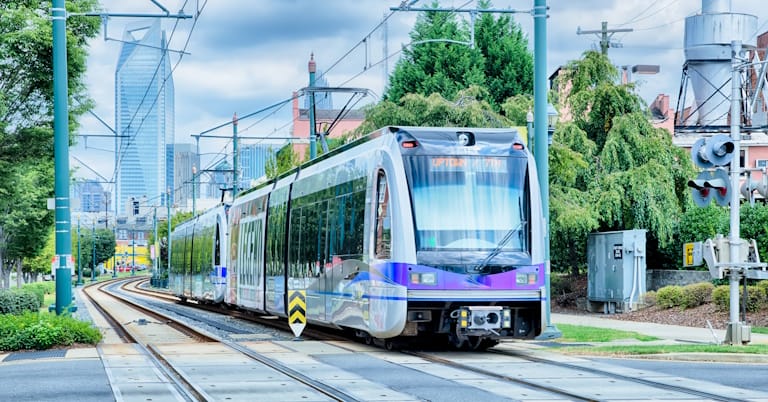

Crystal Oscillators, Including VCXOs, TCXOs and OCXOs, Lead the Way
New and emerging technologies in the automotive and transportation markets promise to make our society safer, more efficient, environmentally sustainable and accessible for all.
These are just a sample of the concepts that will define how we experience transportation in the coming years:
- EV: Electric vehicles are poised to comprise 40% of the vehicle market by 2030, as automakers increase their investment in manufacturing to meet this demand.
- In-cabin features: Safety, connectivity and AI features will transform driving as we know it.
- Micro-mobility and public transportation: Increased attention on these markets promises future landscapes that are free from the ill-effects of private vehicle dependence by mitigating congestion, environmental hazards and more.
- Beyond the wheels: Not solely limited to vehicles, automotive and transportation innovations are expanding for ticketing and fares, scheduling, signage and smart traffic management.
No matter the project, feature or functionality within any of these sectors, they all have something in common. Each requires crystal oscillators with performance characteristics that are vital to the operation of these future-forward technologies.
Keep reading to take a deeper dive into specific innovations in these sectors, as well as the role that crystal oscillators, including VCXOs, TCXOs and OCXOs, will play in the delivery of emerging services we will ultimately depend on as drivers, passengers and consumers.
Crystal Oscillators: The Pulse of Transportation’s Next Wave of Innovations
The following technologies require high-quality timing solutions to ensure that the electric vehicles, automotive in-cabin features, micro-mobility and public transportation markets deliver transformative new products.
Innovations in EV: PwC predicts that the electric vehicle charging market will grow to $100 billion by 2040. They also predict 35 million charging stations by 2030 and nearly as many EVs. Crystal oscillators perform crucial functions for charging stations now to perform key tasks (e.g., initiating a charge, user interface and data transmission). As the demand for this technology grows and users desire more features, the support of high-“Q”-factor clocking will support these initiatives.
Innovations for in-cabin features: One emerging trend for in-vehicle safety is the driver and occupant monitoring system (DOMS). This system uses light and image sensors to monitor driver and occupant behavior, including alertness, engagement and the size of the passenger, in order to adjust safety features, such as airbags, to their stature. Ruggedized, exceptionally stable automotive-qualified crystal oscillators are required for the initiation of reactive responses from the vehicle based on what DOMS sensors observe.
Innovations in micro-mobility: As the use of electric scooters democratizes the commuter playing field as an economically and environmentally viable alternative to cars, longer battery life will prove essential to these products’ success. Connectivity features and safety sensors will require small-form-factor, low-power-draw timing solutions to ensure the ideal relationship between managing the power supply and the many features commuters desire.
Innovations in public transportation: Electronic engineers have their eye on smart ticketing, real-time tracking and connectivity. Each of these technologies are superior examples of how technology frees up human beings to keep us safer, more comfortable and more productive. Real-time tracking keeps commuters informed. Connectivity provides safety and performance data. Smart ticketing frees up public transportation workers to focus on other vital on-board services while reducing overhead. Timing components deliver the communication signals necessary for these functionalities that make transit more desirable. This demand, in turn, has the power to shift our dependence on the resources required for private vehicles.
Continued Reliance on Crystal Oscillators Will Prove Essential
Although emerging and yet-to-be-imagined technologies will require engineering expertise from a new generation of designers, it is comforting to recognize the consistencies that remain in an ever-evolving world. After all, the technologies that drive our world today were kindled long ago during the late 19th and early 20th centuries’ waves of revolutionary invention and patenting.
The crystal oscillator has been a constant throughout the history of electronic engineering. Our public and private transportation vehicles and technologies have relied on this component for decades. As VCXOs, TCXOs and OCXOs entered the marketplace, crystal oscillators took a leap forward alongside the transportation technologies that require their powerful frequency stability.
Crystal oscillators, in their most high-performing, high-quality forms, will once again serve as the relied upon means of synchronization, communication and orchestration for the myriad services that transportation technology will provide in the future.
However, there is one caveat. The leading manufacturers of crystal oscillators must be prepared to build components with the performance and quality that will meet – and anticipate – the needs of the automotive and transportation industry.
ECS Inc. leads the charge in this initiative with products that are up to the challenge now and in the future. Read more about ECS Inc.’s commitment to innovation in this sector with AEC-Q200-qualified components and more.
The Transportation Industry’s Latest Innovations Require the Precision of a Crystal Oscillator was last modified: February 16th, 2024 by